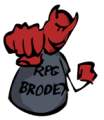Burning Bridges
Enviado de meu SM-G3502T usando Tapatalk
King's Quest III was not rendering the whole scene to implement reflection - it was rendering the very few movable units and drawing that on top of a static, precreated, and almost certainly hand-drawn, "default background reflection". You can do essentially the same thing for any 3D game with a stationary camera as long as most objects (walls, stairs, pictures, tables, etc.) are mostly stationary from one frame to the next -- just render the static reflection once, and then every frame render and superimpose (2D/post-rasterization/cheap operation) only the moving objects that fall within the "mirror's field of view" on top of that static pre-rendered reflection (with the possible added complication of needing a Z buffer or using multiple non-overlapping 2D pre-rendered layers if the static stuff isn't strictly behind {from the mirror's perspective} the moving stuff, and with the down-side that that may not compute all of your lighting correctly - though you could probably fake that too to some extent - lighting is all fakery anyways so computing it "correctly" is never really an option).
Or you can just be a lazy-ass programmer and render the whole scene.
The key here is that the angle you view the mirror from is always the same. That's not the case in a 3d or 2.5d game.
Angle or not, isn't this relatively straightforward to implement by a camera? The content of the mirror is the camera, camera position is = center mirror position and camera angle is always -1 * Angle PlayerMirror ?
Of course this needs to get optimized so that the camera gets only calculated when the mirror is in the FOV of the player, renders at lower quality, etc


































 is that the really good people all have companies of their own or better paid jobs elsewhere, whereas in the good old days they often ended up in small companies and made great games, at least when they were still young. Today PC games are mostly made by the riff raff. I mean even I was considering game development at some point, luckily I never went past the prototyping stage or I could be the center of endless derision now
is that the really good people all have companies of their own or better paid jobs elsewhere, whereas in the good old days they often ended up in small companies and made great games, at least when they were still young. Today PC games are mostly made by the riff raff. I mean even I was considering game development at some point, luckily I never went past the prototyping stage or I could be the center of endless derision now 

